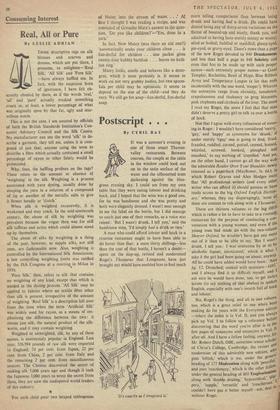Consuming Interest
Real, All or Pure
By LESLIE ADRIAN
This is not the case, t am assured by officials of both the British Standards Institution's Con- sumer Advisory Council and the Silk Centre. No manufacturer can use the word 'silk' to de- scribe a garment, they tell me, unless it is com- posed of just that; anyone using the term to describe a fibre which actually contained a small percentage of rayon or other fabric would be prosecuted.
Why, then, the baffling prefixes on the tags? These relate to the amount or absence of `weighting' in the silk. Weighting is a process associated with yarn dyeing, usually done by steeping the yarn in a solution of a compound of tin or another of the metallic salts to give it firmer handle or 'clutch.'
When silk is weighted excessively, it is weakened and may crack. In the mid-nineteenth century, the abuse of silk by weighting was prevalent because the vogue then was for stiff silk taffetas and satins which could almost stand up by themselves.
The abuse of silks by weighting is a thing of the past, however, as supple silks, not stiff ones, are fashionable now. Also, weighting is controlled by the International Silk Association; a law controlling weighting limits was ratified by the ISA Congress at a meeting in Milan in 1954.
'Pure Silk,' then, refers to silk that contains no weighting of any kind, except that which is needed in the dyeing process. 'All Silk' may be applied to fabrics where no textile fibre other than silk is present, irrespective of the amount of weighting. 'Real Silk' is a description left over from the time when the term 'Artificial Silk' was widely used for rayon, as a means of em- phasising the difference between the two: it means just silk, the natural product of the silk- worm, and it may contain weighting.
Weighted or unweighted, silk, by any of these names, is enormously popular in England. Last year, 526,994 pounds of raw silk were imported to England; 74 per cent. from Japan, 22 per cent. from China, 2 per cent. from Italy and the remaining 2 per cent. from miscellaneous sources. The Chinese discovered the secret of making silk 5,000 years ago and though it took the Japanese 3,000 years to wrest the secret from them, they are now the undisputed world leaders of this industry `For each child pour two heaped tablespoons of Matey into the stream of water. . . At first I thought I was reading a recipe, and was reminded of Grouch() Marx's answer to the ques- tion, `Do you like children?'—`Yes, done to a turn.'
In fact, New Matey (was there an old one?) `automatically soaks your children clean . . . is fun-derful for children . . . one packet gives twenty-four bubbly bathfuls . . . leaves no bath- tub ring.'
Matey looks, smells and behaves like a deter- gent, which it most probably is. It seems to work on not very grubby bodies, but two spoon- fuls per child may be optimistic. It seems to depend on the size of the child—and they do vary. We still go for soap—fun-derful, fun-derful soap.










































 Previous page
Previous page